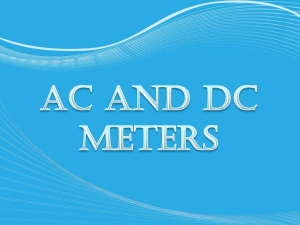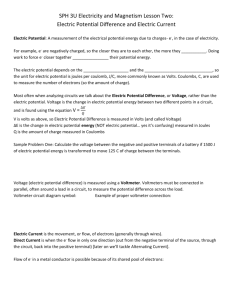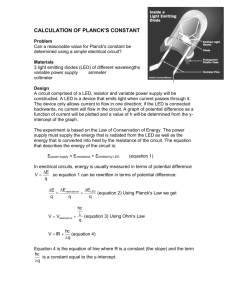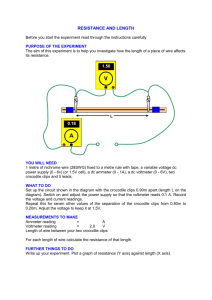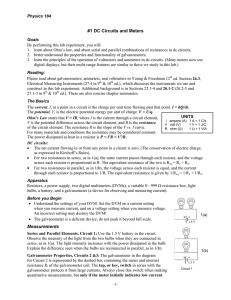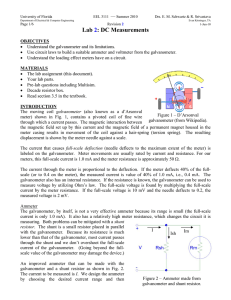voltmeter - mrhsluniewskiscience
advertisement
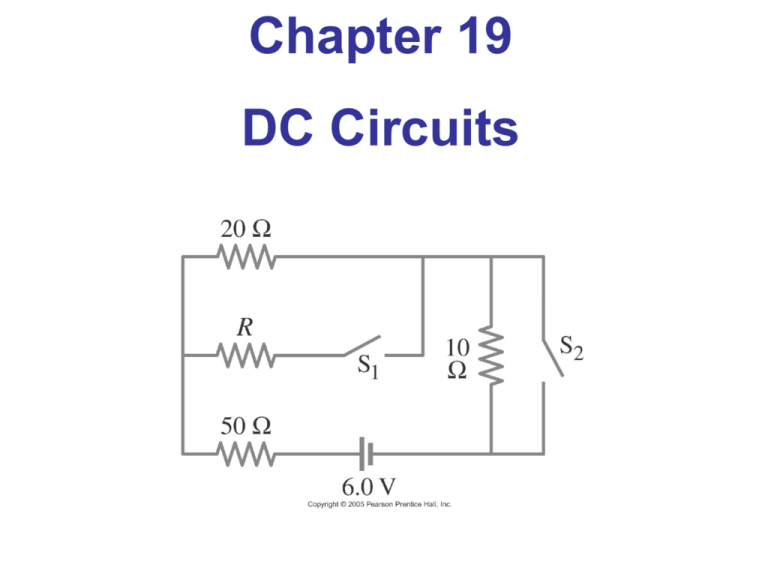
Chapter 19 DC Circuits Objective: The students will be able to: Describe the basic operation of a galvanometer and calculate the resistance which must be added to convert a galvanometer into an ammeter or a voltmeter. 19.7 Electric Hazards Even very small currents – 10 to 100 mA can be dangerous, disrupting the nervous system. Larger currents may also cause burns. Household voltage can be lethal if you are wet and in good contact with the ground. Be careful! 19.7 Electric Hazards A person receiving a shock has become part of a complete circuit. The current in (a) passes from the high-voltage wire through the person to to ground through the bare feet, and back along the ground to the ground terminal of the source. What is shoes were on? In (b), the person touches a faulty “hot” wire with one hand, and the other touches a sink faucet (connected to ground via the pipe or water in a non-metal pipe). The current will pass through the chest, through the heart and lungs, which makes it dangerous. Useful rule: If one hand is touching something electrical, put other hand behind back and wear thick rubber-soled shoes. 19.7 Electric Hazards Faulty wiring and improper grounding can be hazardous. Make sure electrical work is done by a professional. Case b: A wire inside the device came in contact with the case and the case is metal so it conducted electricity. Case c: The metal case is connected directly to the ground by a separate wire. If a “hot” wire touches the grounded case, a short circuit to ground immediately occurs and most of current passes through the low-resistance ground wire. 19.7 Electric Hazards The safest plugs are those with three prongs; they have a separate ground line. Here is an example of household wiring – colors can vary, though! Be sure you know which is the hot wire before you do anything. 19.8 Ammeters and Voltmeters An ammeter measures current; a voltmeter measures voltage. Both are based on galvanometers, unless they are digital. The current in a circuit passes through the ammeter; the ammeter should have low resistance so as not to affect the current. Galvanometer • The galvanometer is the "classic" device to measure current • Based on the fact that a wire carrying current in a magnetic field feels a force 8 • The current flows through a coil in a magnetic field • The coil experiences a torque proportional to current • The movement of the coil is "opposed" by a spring • The deflection of the needle is proportional to current 9 measuring current Electric current is measured in amps (A) using an ammeter connected in series in the circuit. A measuring current This is how we draw an ammeter in a circuit. A A SERIES CIRCUIT PARALLEL CIRCUIT Ammeter Ammeter is a low resistance galvanometer It is used to measure the current in a circuit in amperes Galvanometer can be converted into an ammeter by using a low resistance wire in parallel with the galvanometer the resistance of the wire depends upon the range of the ammeter As shunt resistance is small the combined resistance of the galvanometer & the shunt is very low hence the ammeter has much lower resistance than galvanometer An ideal ammeter has zero resistance 19.8 Ammeters and Voltmeters A voltmeter should not affect the voltage across the circuit element it is measuring; therefore its resistance should be very large. measuring voltage The ‘electrical push’ which the cell gives to the current is called the voltage. It is measured in volts (V) on a voltmeter V Voltmeter Voltmeter is an electrical measuring device, which is used to measure potential difference between two points in a circuit. CONNECTION OF VOLTMETER IN CIRCUIT Voltmeter is always connected in parallel to a circuit. SYMBOL Voltmeter Volt meter is a high resistance galvanometer It is used to measure the potential difference between two points of a circuit in volts A galvanometer can be converted into a volt meter by using a high resistance in series with the galvanometer The value of resistance depends upon the range of the volt meter For voltmeter a high resistance, R is connected in series with the galvanometer therefore resistance of voltmeter is very large as compared to that of galvanometer The resistance of an ideal voltmeter is infinity measuring voltage This is how we draw a voltmeter in a circuit. V SERIES CIRCUIT V PARALLEL CIRCUIT 19.8 Ammeters and Voltmeters An ohmmeter measures resistance; it requires a battery to provide a current 19.8 Ammeters and Voltmeters If the meter has too much or (in this case) too little resistance, it can affect the measurement. Summary of Chapter 19 • A source of emf transforms energy from some other form to electrical energy • A battery is a source of emf in parallel with an internal resistance • Resistors in series: Summary of Chapter 19 • Resistors in parallel: • Kirchhoff’s rules: 1. sum of currents entering a junction equals sum of currents leaving it 2. total potential difference around closed loop is zero Summary of Chapter 19 • Capacitors in parallel: • Capacitors in series: Summary of Chapter 19 • To avoid shocks, don’t allow your body to become part of a complete circuit • Ammeter: measures current • Voltmeter: measures voltage Closure: Kahoot: 19-7 and 19-8




